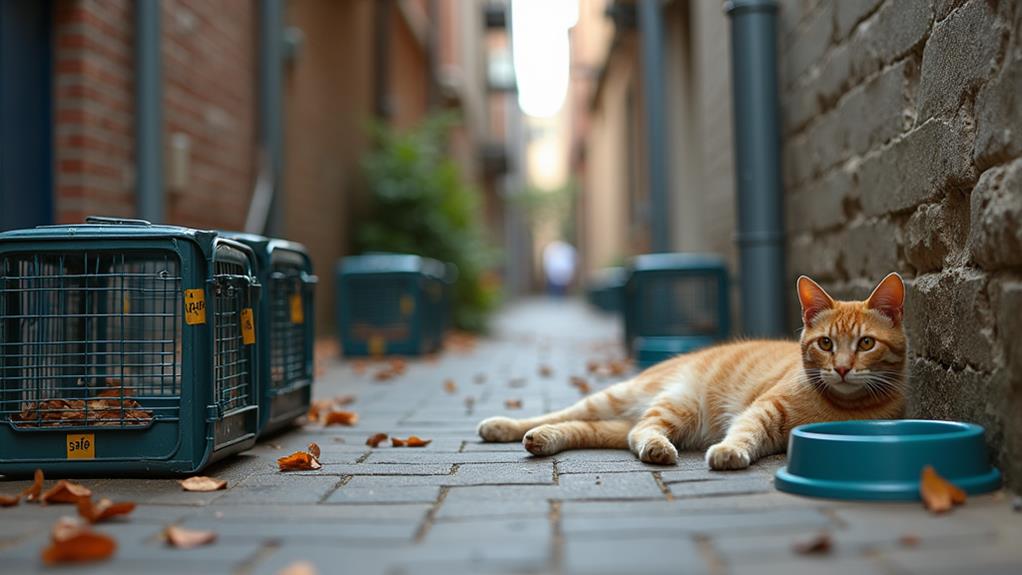How to Help a Feral Cat: Tips for Providing Care and Support
To help feral cats, start by understanding their needs. Build insulated shelters using straw for bedding and guarantee they're raised off the ground. Establish a feeding routine with high-quality food, increasing rations in the winter. Keep the area clean to prevent pests. Health checks and vaccinations are vital, along with flea prevention. Practice trap-neuter-return (TNR) to control the population humanely. Engage your community by organizing educational workshops and setting up shared feeding stations. Socialize feral kittens early to aid in rehoming them as companions. There's so much more you can do to positively impact their world.
Understanding Feral Cats
In regards to understanding feral cats, it is essential to recognize that these are unsocialized domestic cats that typically shun human contact and often form colonies. These community cats are born to stray or abandoned cats, living in groups called cat colonies. The feral cat population in the U.S. ranges from 60 to 100 million, with these cats primarily residing outdoors, scavenging in dumpsters and alleys.
Helping feral cats involves addressing their rapid population growth. Spaying and neutering are fundamental steps, as female feral cats can become pregnant at 16 weeks, producing multiple litters annually. This can lead to an overwhelming number of feral kittens if unchecked. Collaborating with your local Humane Society can facilitate trap-neuter-return (TNR) programs, effectively managing the population.
Beyond TNR, providing consistent access to food and shelter is significant. You can place water bowls in safe locations to guarantee they have clean drinking water. Remember, even though feral cats are self-sufficient, they face numerous challenges, including harsh weather and disease. By supporting these efforts, you contribute to the well-being of feral cats and help maintain a balanced ecosystem in your community.
Providing Essential Shelter
When helping feral cats, providing essential shelter is necessary for their survival, especially in harsh weather conditions. You'll want to offer insulated shelters that are at least 2x3 feet in size and 18 inches high. Use straw for bedding to retain warmth and prevent moisture accumulation. This setup guarantees the cats remain dry and cozy. Equip the shelters with small entryways and flaps. These features block cold air and prevent larger animals from entering, while also keeping the shelters clean. Raise them off the ground to avoid waterlogging during rainy or snowy conditions.
It's imperative to provide multiple shelters, each accommodating 3-5 cats. This allows them to huddle together for warmth, enhancing their chances of coping with cold weather. Use materials like foam cooler bins or Rubbermaid containers to construct durable shelters that are both effective and easy to clean. Regularly inspect and maintain these shelters. Check them for snow blockage or any damage to confirm they remain safe and accessible. Don't forget to place the shelters near feeding stations for easy access. By taking these steps, you'll greatly improve the lives of feral cats in your community.
Feeding and Hydration Tips

Caring for feral cats requires thoughtful feeding and hydration strategies to guarantee their well-being, especially in challenging weather conditions. Start by establishing a routine with high-quality feeding once daily. Canned food is ideal, particularly in winter, due to its higher fat content that helps maintain body heat. Use feeding stations to shield the food from harsh weather and wildlife, making sure it remains accessible but not left out for too long to prevent attracting pests.
In colder months, increase food rations to support the cats' energy needs. Consider using insulated bowls or heated ones to keep water from freezing, as hydration is vital even in winter. Regularly monitor water levels and provide fresh food and water daily, with electrically heated bowls being a wise choice for outdoor cats.
Maintaining cleanliness at feeding sites is important. Remove uneaten food within 30 minutes to deter rodents and pests, which also fosters goodwill with your neighbors. Remember, feeding feral cats also involves considering long-term solutions like spay or neuter programs to manage the population. By following these tips, you'll guarantee the cats are well-fed and hydrated throughout the year.
Health and Safety Measures
Guaranteeing the health and safety of feral cats involves several critical steps that require your attention. Initially and foremost, regular veterinary check-ups are vital to address potential health issues and guarantee vaccinations are up to date. Vaccinations not only protect feral cats from diseases like feline leukemia and rabies but also prevent disease transmission to household pets. Flea prevention is another key aspect, as infestations can cause severe discomfort and health problems.
To maintain a clean environment, practice good hygiene by washing your hands after handling feral cats or their food and water bowls. This helps prevent zoonotic diseases from spreading to humans. Your feeding stations should also be kept clean. Regularly check these areas for spoilage and remove any food waste to deter pests. Furthermore, consider having feral cats spayed or neutered to control the population and reduce health risks.
Here's a quick checklist to guide you:
- Schedule regular veterinary check-ups for vaccinations and health monitoring.
- Implement flea prevention measures.
- Practice good hygiene to prevent disease transmission.
- Maintain clean feeding stations to promote health.
- Seek medical advice for spaying or neutering.
Implementing TNR Programs

Implementing Trap-Neuter-Return (TNR) programs is a humane and effective strategy for controlling feral cat populations. By trapping feral cats, spaying or neutering them, and returning them to their original locations, you help prevent the staggering number of potential offspring—up to 420,000 from a single female in seven years. This approach not only manages feral cat populations but also improves their health through vaccinations, reducing disease transmission within colonies.
Unlike the traditional Catch and Kill method, which often results in a "vacuum effect" where new cats quickly replace those removed, TNR programs offer a sustainable solution. Removing cats can inadvertently lead to population rebounds, but TNR addresses the root of the issue by stabilizing colony sizes.
Community involvement is essential to the success of TNR programs. When you support local residents by volunteering for cat trapping, fundraising for veterinary care, or spreading awareness about the benefits of TNR, you play an important role in the program's success. Engaging with your community guarantees the program's longevity and effectiveness, ultimately creating healthier environments for both feral cats and humans. Together, we can make a difference through compassionate and practical approaches.
Community Engagement Strategies
While TNR programs offer a sustainable solution to managing feral cat populations, their success relies heavily on active community engagement. You can make a difference by organizing educational workshops that highlight the benefits of Trap-Neuter-Return. These workshops can show how neutered and vaccinated cats contribute to reducing feral cat populations and improving their general health. Collaborating with local veterinarians and animal organizations can help you establish a network of dedicated volunteers. These connections streamline efforts to capture, neuter, and return feral cats efficiently.
Community feeding stations and shelters are also essential. By setting these up, you encourage residents to take part in caring for feral cats while maintaining a cleaner environment. Hosting fundraising events can generate much-needed resources for TNR initiatives, supporting veterinary care and supplies.
To spread awareness, use social media to share success stories of community involvement. This not only inspires others but also fosters a sense of responsibility toward local wildlife.
Here's how you can engage your community:
- Organize educational workshops
- Collaborate with local veterinarians
- Set up community feeding stations
- Host fundraising events
- Share success stories on social media
Your efforts can make a significant impact!
Socializing and Rehoming Kittens

Socializing feral kittens is a rewarding endeavor that requires patience and dedication. The vital window for socialization occurs when kittens are about five to six weeks old. During this time, consistent handling is key to helping them develop trust in humans. As a caregiver, your efforts should focus on creating a structured environment where these young feral cats can learn to feel safe and comfortable. Providing gentle interactions will help them adapt and eventually thrive in a home setting.
Before you consider rehoming, it's important to spay or neuter the kittens, typically around twelve weeks old. This step is pivotal to prevent further overpopulation issues. Organizations like Feral Cat Focus of WNY offer socialization programs specifically tailored for these kittens. They provide invaluable resources and guidance to help you along the way.
Keep in mind that feral kittens need more time and patience than their domesticated relatives. Neonatal kittens, especially those under four weeks old, require round-the-clock care, including bottle feeding. Immediate intervention can make all the difference in their early lives. With the right approach, you can transform these feral kittens into loving companions ready for their forever homes.




